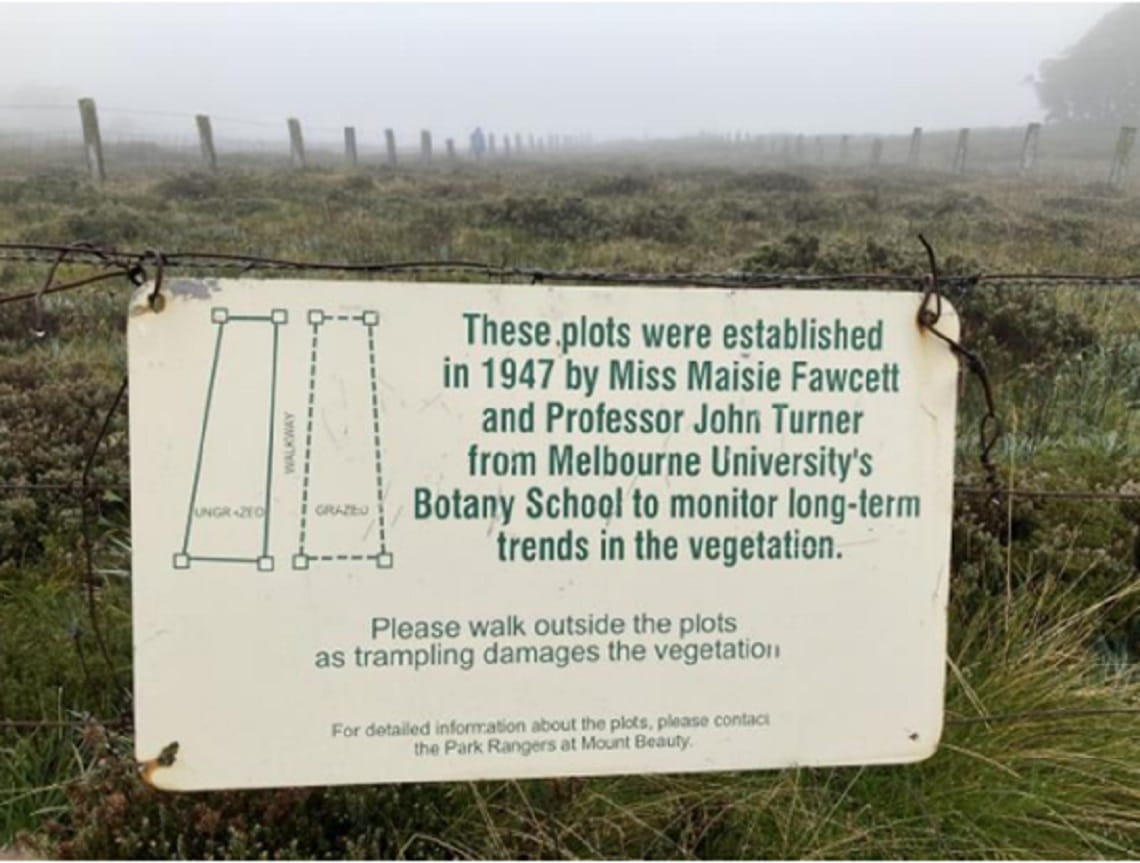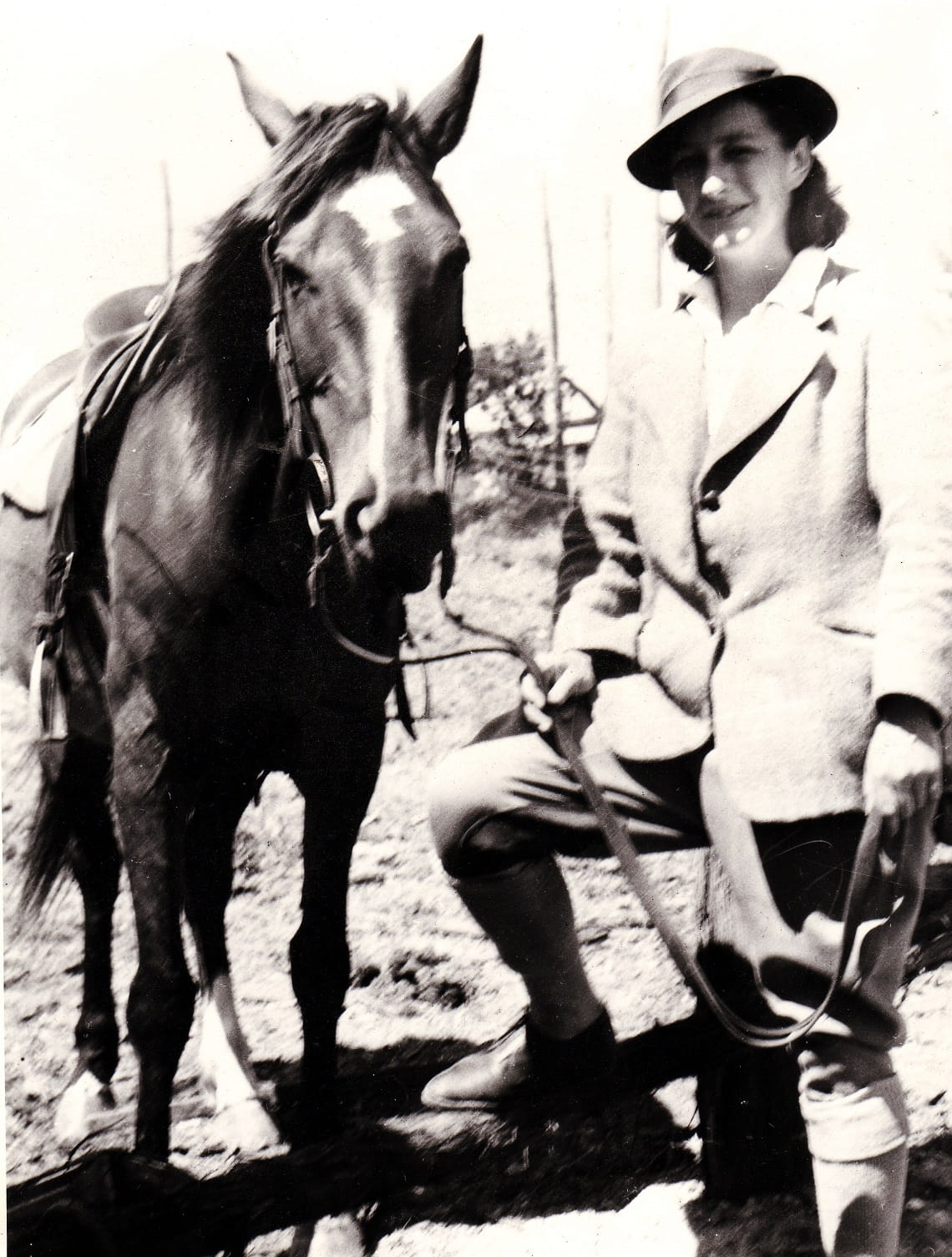Maisie's Plots
Wednesday 15 October, 2025
Amazing Maisie – getting the good dirt to protect our water
This International Day of Rural Women (15 October), we celebrate the legacy of Stella Grace Maisie Fawcett (1912–1988), a pioneering botanist whose work in Victoria’s Alps transformed ecological science and land management, whose work with soil erosion revolutionised farming and grazing practices throughout Victoria’s High Country.
Maisie’s Plots have become one of the longest continual grassland monitoring projects in the world and are still in use today. Initially established as part of a research project to understand how to protect water catchment areas, the plots now play an important role in the conservation of Victoria’s fragile alpine ecosystem.

Pretty Valley Plot Interpretative signage, 2022. Image Heritage Victoria
Amazing Maisie
Born in 1912 in the Melbourne working-class suburb of Footscray, Maisie was dux of her primary school and won a university ‘free place’ after attending Melbourne High School. After time as a school teacher, she attended the University of Melbourne, graduating Bachelor of Science in 1935 and Master of Science in 1936 majoring in botany with honours.
With research scholarships and grants she undertook fungal research in the university’s Botany Department. In 1940 an accident to her head and neck prevented further microscope work.
Her field-based research role in the High Country was initially thought to be best suited to a man, given the difficult working conditions in the Australian Alps. However, it was wartime and male ecologists were in short supply. Cue Maisie Fawcett, talented female postgraduate botanist! From September 1941, Maisie moved to the remote town of Omeo.

Maisie Fawcett with her horse Sheila, Bogong High Plains, 1949: Image supplied Marion Manifold
Being a city-bred woman, a scientist, a representative of both the University and the Soil Conservation Board was not easy in a rural community. Not surprisingly, Maisie overcame entrenched conservative attitudes, wartime shortages, physical exhaustion and challenging terrain and weather conditions.
The urgent need for monitoring
In 1944, Maisie Fawcett began research work on an urgent ecological project investigating widespread soil erosion in the catchment of the new Hume Weir.
She was studying the rate and scale of soil erosion (the wearing away of the top level of soil caused by wind, water, ice, snow, plants and animals) in the Australian Alps.
The nationally significant Hume Weir had opened in 1936 to provide fresh water to communities across Victoria and New South Wales.
Also known as the Hume Dam in the Murray Darling Basin, it was the second largest dam in the world when it opened and is still a key part of eastern Australia's water management infrastructure today.

Maisie (right) with other members of the Soil Conservation Board, which backed her research into erosion. Image supplied: Marion Manifold
The weir is fed by rain and melting snow from a catchment area spanning 16,000 square kilometres, encompassing a considerable portion of the Australian Alps –where Maisie’s research was centred.
The 1939 January Black Friday bushfires had hastened the rate of soil erosion across this area and more research was needed to protect water catchment areas and dams to prevent an expensive problem for government water projects - siltation.
Siltation is a type of water pollution where small particles of soil, clay or sand gather and cause blockages.
From 1944 to 1947, Maisie established four now-famous research plots on the Bogong High Plains.
Rocky Valley Plots
- Established 1944-45.
- One large fenced exclosure in Rocky Valley (a peatland area with various vegetation types) which excluded cattle
- One an unfenced control area in which cattle could graze
Pretty Valley Plots
- Established in 1946
- One exclosure on the edge of Pretty Valley (grassland area) which was fenced in 1947 to exclude cattle
- One unfenced control area in which cattle could graze
These plots are thought by many in the scientific community to be one of the foundations of non-Aboriginal Australian ecology and were among the first such exclosure plots in Australia.
‘Exclosure’ plots are made by fencing around small vulnerable habitats to collect information on what the environment should look like without damage from people and introduced animals.
Maisie Carr (nee Fawcett) at Maisie's Plots. Image supplied Marion Manifold
What did Maisie find?
While living in Omeo, Maisie monitored vegetation in the two plots, which at the time contained two eroded areas that were fenced to exclude rabbits and stock.
She covered long distances on horseback, investigated gully erosion and tested introduced grasses and fertilisers in pasture experiments.
Her extensive, unpublished report documented widespread degeneration of vegetation and loss of soil due to over-grazing.
After a decade of monitoring, the botanical changes recorded through her work would provide scientific evidence of the destructive effects of cattle grazing on the vegetation and soils of Victoria’s high country.
Maisie’s investigations were not always welcome. She criticised the cattlemen's frequent burning of vegetation and examined the effects of rabbits and stock on indigenous pastures. Her research earned her the titles of ‘Washaway Woman’ and ‘Erosion Girl’. That said, Maisie slowly and consistently won the respect of cattlemen, of Soil Conservation Board members and others by speaking not only from her love for the high country, but from the clear, uncluttered evidence that the land itself was revealing.

Blairs Hut, Maisie Fawcett (left) with her brother Frank
Maisie also contributed to Leonard Stretton's 1946 Royal Commission to Inquire into the Causes and Measures Taken to Prevent the Bush Fires of January 1939. Representing the Soil Conservation Board, Maisie was the only woman on the Bogong High Plains Advisory Committee which determined the permissible number of cattle and length of their stay each summer.
It wasn’t until after Maisie’s death in 1988, that her husband, Professor Denis John Carr provided funds to have her accumulated ecological data published.
In August 2022, the Victorian Heritage Register (VHR) recommended the two unremarkable looking ecological monitoring sites in the Bogong High Plains be listed on the register due to their cultural heritage significance to the state of Victoria.
Read more about the historical significance of Maisie’s Plots at the Victoria Heritage Register, https://vhd.heritagecouncil.vic.gov.au/places/208374.





